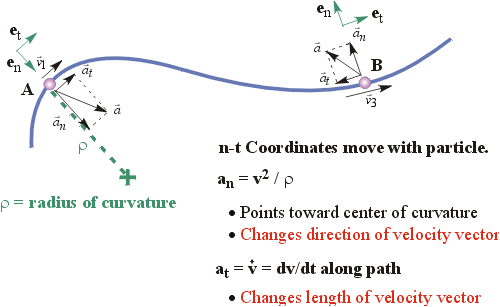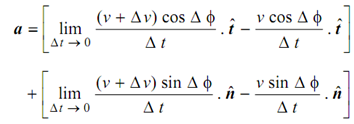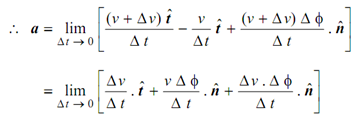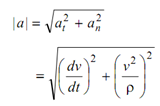Mathematical Representation of Curvilinear Motion:
Let t^′ and n^′ make an angle Δ φ along with their old directions. Now we extend the unit normal vectors n^ and n^ and let them meet at C which is called as the centre of curvature and length CP = ρ is called the radius of curvature.
∴ Δ s = ρ . Δ φ
Δ s / Δ t = ρ Δ φ/ Δ t


The velocity at point P′ shall be different from velocity at P and may be written as v + Δ v . The change in velocity Δ v shall be a vector and shall be caused by an increase in the magnitude plus a change in the direction of vector V at P as illustrated in Figure
v + Δ v = (v + Δ v) t ′(Vectorially)
so, acceleration a shall be

As Δ t → 0, P′ → P
Resolving along tangent and normal at P.

but as Δ t → 0, Δ φ → 0 and lim sin φ = φ and lim cos φ = 1.

Δ v . Δ φ is the product of two small quantities, therefore we neglect it. Also we have
Δ φ = Δ s /ρ and Δ s / Δ t = v

= dv /dt . t^ + (v 2 / ρ ). n^
If at = tangential component of acceleration, and an = normal component of acceleration.
Then
a = at t^+ an n^
= dv/ dt . t^ + (v2/ ρ) . n^

This resultant acceleration shall make an angle β with the normal to the curve at P.
Then tan β = at / an ,
Here, we should remember that normal acceleration is oriented towards the centre of curvature C.
In case of rectilinear motion ρ = ∞ and an = 0. The acceleration a = at = dv / dt and shall be always along the path of the particle. If equation of the path of the particle is specified by
y = f ( x) , then the radius of curvature at a point whose coordinates are x and y is given
by
1/ ρ = ± (d 2 y/ d x 2) / [1+ (dy/dx)2] (3/2)